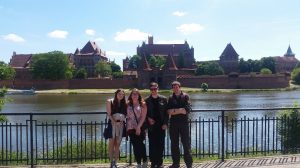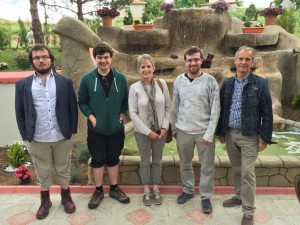This year to mark International Women’s Day we asked Echo Rew, a recent graduate, and Laura Hampden, who graduated in 2013, to reflect on women in archaeology – how far we’ve come, and how far we still have to go.
Echo Rew (BA Ancient History and Archaeology)
“I am a Post-Excavation Officer at Thames Valley Archaeological Services (TVAS).
The improvement for women in archaeology over time is undeniable. Although there are still challenges that unfortunately some women (and men) have to face consistently throughout their career, the progress cannot be disputed. I think one of the main reasons for this is the increased communication on the subject. During my time at university this topic, although somewhat difficult to address, was never shied away from in the archaeology department. Instead, it was embraced in an open discussion approaching the matter without a rose-tinted view. It gave us not only a realistic insight into life after university but also the ability to deal with these situations should we come across them during our careers.
A definite change in perspective is becoming more prominent and, most importantly, we now have role models. Every day we would go into our lectures and see women spearheading research projects, winning awards or writing papers, thus creating a culture of respect and encouragement within the department regardless of gender; giving us the confidence in our ability and the fact that I am a woman means absolutely nothing to my ability to do my job. I am lucky enough to have graduated university and moved into a commercial archaeology firm in which this perspective is very much at the forefront and I am given the daily support, encouragement and opportunities to progress in the field with my gender being completely irrelevant.
It would be impossible to say that everything is perfect for women in archaeology – the challenges and imbalance is still there however to say that there has been no progression in regards to the issues that female archaeologists face would be untrue. Nevertheless it is difficult to distinguish whether the issues facing women in archaeology specific to the field or just representative of wider societal perception.”
Laura Hampden (BSc Archaeological Science)
“I studied for an Archaeology BSc degree at University of Reading graduating in 2013. I really enjoyed my time at Reading. I loved that there was a broad range of modules on offer that gave me a chance to develop my own interests and gave me a solid foundation and understanding of Archaeology and archaeological practice here in the UK.
I started work as a Historic Environment Records (HER) Assistant at West Berkshire Council within a few weeks of graduation. I had learned about HER’s and Planning Archaeology within a Professional Practice module at Reading, and used HER data within my dissertation. I’m now a Historic Environment Record Project Officer at Historic England within the Greater London Archaeological Advisory Service.
Over the years there has been some change for women in archaeology. Having spoken to women who have been working in the sector for 20-30years it was much harder to get by, and gender dynamics were very hard to navigate.
I graduated in 2013, and thinking back on it it now I was really spoiled to have been able to learn from leaders in the field, who were also women at Reading Uni. And to have had a great female manager and mentor at West Berkshire within my first professional role. I thought this was common place but in reality while there are more women who study archaeology at university than men, and more women within the profession than men, there is still an imbalance favouring men at a higher career levels.
So, there are still a few challenges to overcome. I’ve noticed there is a tendency for women, people of colour, and people from more working class backgrounds to carry with them a sense of ‘imposter syndrome’. Which is basically a feeling of inadequacy, or feeling the need to constantly prove that we deserve to be here; working in an environment or space that was not traditionally designed for us to occupy.
That said recently there has been a real energy and desire within the profession to change this. I have found that women really support each other within this profession. There are now far more opportunities for mentorship and support from other women who are well established within the profession. And there are some great people and groups within the sector working together to challenge inequality, and create a more diverse and representative environment. Joining these groups, sharing stories, hearing about and celebrating the success of women within the sector is the key to change. We need to encourage each other and support women to go for those top positions.”













 This is the
This is the


 From November 21st -25th 2014 a small team from the University of Reading Archaeology Department took advantage of a low tide to investigate Mesolithic sites in the intertidal zone at Goldcliff, South Wales where many archaeological discoveries have been made over the last 24 years. We found human, bird and deer footprints, Mesolithic flints and charred hazel nuts. The fieldwork was in conjunction with a team from the
From November 21st -25th 2014 a small team from the University of Reading Archaeology Department took advantage of a low tide to investigate Mesolithic sites in the intertidal zone at Goldcliff, South Wales where many archaeological discoveries have been made over the last 24 years. We found human, bird and deer footprints, Mesolithic flints and charred hazel nuts. The fieldwork was in conjunction with a team from the  undergraduate degree. After this she did a MSc in Forensic Archaeology at University College, London and her current PhD project has been funded by the Arts and Humanities Research Council. Fieldwork with the BBC team provided an early opportunity in the second month of her project to get information about the project out to the public.
undergraduate degree. After this she did a MSc in Forensic Archaeology at University College, London and her current PhD project has been funded by the Arts and Humanities Research Council. Fieldwork with the BBC team provided an early opportunity in the second month of her project to get information about the project out to the public.